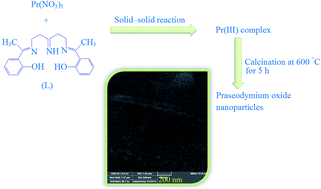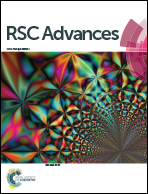Praseodymium oxide nanostructures: novel solvent-less preparation, characterization and investigation of their optical and photocatalytic properties
Abstract
Praseodymium oxide (Pr6O11) nanostructures were prepared via a new simple solvent-less route. The nanostructures were synthesized by a heat treatment in air at 600 °C for 5 h, using [Pr L(NO3)2]NO3 (L = bis-(2-hydroxy phenyl methyl ketone)-dipropylene triamin Schiff base ligand), as a precursor, which was obtained by a solvent-free solid–solid reaction from different molar ratios of praseodymium nitrate and a Schiff base ligand. The as-prepared nanostructures were characterized by means of several techniques including X-ray diffraction (XRD), thermo-gravimetric analysis (TGA), scanning electron microscopy (SEM), energy dispersive X-ray microanalysis (EDX), photoluminescence (PL) spectroscopy, transmission electron microscopy (TEM), nuclear magnetic resonance spectroscopy (1H NMR) analysis, UV-vis diffuse reflectance spectroscopy and Fourier transform infrared (FT-IR) spectroscopy. The obtained results showed that the morphology and particle size of the final Pr6O11 could be dramatically affected via the molar ratio of praseodymium nitrate and the Schiff base ligand. The photocatalytic activity of the as-synthesized nanostructures was also investigated by the degradation of 2-naphthol as an organic contaminant under ultraviolet light irradiation.


 Please wait while we load your content...
Please wait while we load your content...